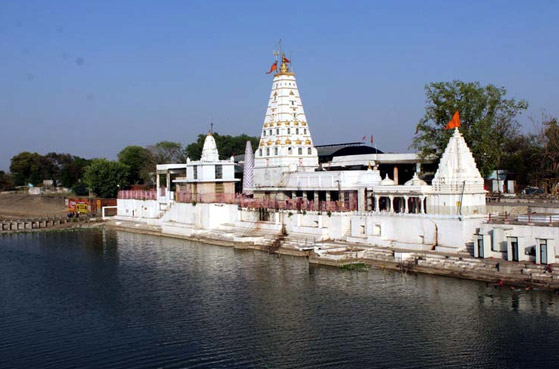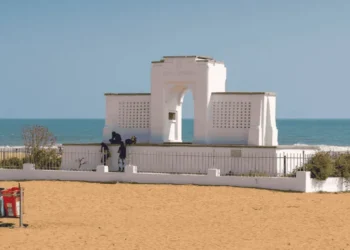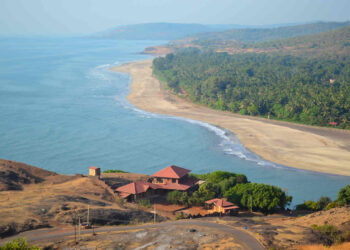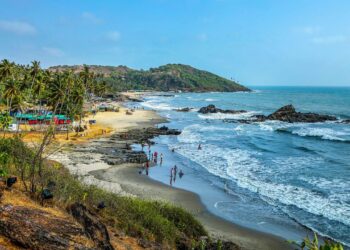Set on the banks of the Shivna River in Mandsaur, Madhya Pradesh, the Pashupatinath Temple is a sacred shrine where devotees worship Lord Shiva, known here as Pashupatinath, the lord of all beings. Built long ago, with roots in the 5th or 6th century AD during the Gupta era, this temple is famed for its rare eight-faced Shivlinga. It belongs to Pashupatinath tradition which is one of 6 major tradition within Shaivism drawing many seeking peace and blessings.
Notable Fact: The temple’s Ashtamukhi Shivlinga, with eight faces carved in two rows, is one of only two such Pashupatinath idols in the world, the other being in Kathmandu, Nepal.
Overview of Pashupatinath Temple
The Pashupatinath Temple stands in Mandsaur’s southern part, on Tapeshwar Ghat by the Shivna River, 3 kilometers from the city center. Known for its 4.5-meter-tall, eight-faced Shivlinga, it is a key shrine in the Pashupatinath tradition of Shaivism, one of six major paths. The temple’s simple stone form, rebuilt after medieval damage, holds a serene yet grand feel, with four doors opening to all directions. Devotees offer milk and bilva leaves, believing Shiva fulfills their wishes. The temple trust and district administration keep it neat, with new halls being built to welcome growing crowds. It is a sacred stop for Hindus, tied to Mandsaur’s ancient name, Dashapura.
History of Pashupatinath Temple
Tales say the temple’s roots go back to the 2nd century CE, when Mandsaur, then Dashapura, was a Hindu pilgrimage hub, praised by poet Kalidasa for its charm. Inscriptions from 404–487 CE, found nearby, speak of Gupta-era kings and temples, though they name Surya and Vishnu shrines, not Pashupatinath. The eight-faced Shivlinga, carved in the 1st millennium CE, likely dates to the 5th or 6th century, per its style. Legend claims it rose from the Shivna River in 1940, found by a laundryman, Udaji, who washed clothes on it, or by a cowherd, Punya Dasa, in the 6th century, guided by divine signs. After 21 years, it was placed here, marked by a mela. Medieval Muslim conquests razed many temples, using their stones for a fort, but the Shivlinga survived. The temple was rebuilt, with modern additions in the 1960s. Now, it draws devotees, especially during monsoons when the Shivna touches the linga, seen as a miracle.
Architecture of Pashupatinath Temple
The Pashupatinath Temple, set on a 90-foot-long, 30-foot-wide platform by the Shivna, follows North Indian style, with a high peak and plain stone walls. Its sanctum holds the Ashtamukhi Shivlinga, 7.3 feet high in curve, 11.25 feet straight, weighing 4.6 tons, carved from dark, fiery rock. The linga’s eight faces, in two rows—upper clear, lower faint—show Shiva as Bhava, Pashupati, Mahadeva, Ishaan, Rudra, Sharva, Ugra, and Ashani, each tied to life’s stages, like youth or maturity. Four doors in all directions let devotees enter freely, a rare design. A 100-kg gold-plated pitcher adds shine. Smaller shrines for Hanuman and Janaki Nath sit in the complex, neat and true.
Sculptures of Pashupatinath Temple
The temple’s heart is the Ashtamukhi Shivlinga, a rare icon from the Gupta era, its eight faces showing Shiva’s many forms, cut deep but partly worn below. Hanuman’s idol, red and bold, stands in a side shrine, plain stone. Janaki Nath’s statue, smaller, adds a soft touch, fine work. The outer walls have few carvings, mostly floral marks, simple and neat, as medieval damage left much lost. A few modern panels show Shiva’s tales, like his dance or meditation, cut clear but plain.
Rituals and Prayers
The temple hums with daily rites. Mahashivratri in February brings huge crowds, with all-night prayers, bilva leaves, and milk poured for Shiva. Kartik Ekadashi in October or November hosts a three-day Pashupatinath Mela, with shops and songs by the Shivna. Special prayers, like Rudra Puja, bringing blessings to the devotees. A stall gives free tilak, white tilak, as prasad. Mondays, devotees bring milk for Shiva, for peace, for strength. The Shivna’s ghats see holy baths on big days, pulling all to pray. The air stays divine, real divine.
Information for Travelers
Hours and Entry: Open daily, 6:00 AM to 8:00 PM, sometimes sunrise to sunset. Entry is free for all, a fair deal. No photos in the sanctum, respect the holy space.
Clothing: Wear clothes covering shoulders and knees, proper and plain. For prayers, women wear sarees or suits, men wear kurtas, plain kurtas.
How to Get There:
Air: Indore Airport, 230 km away, is closest. Taxis take 4 hours, cost ₹3000–5000, a steady trip. Udaipur Airport, 205 km, is another option.
Train: Mandsaur Station, 3–5 km away, links to Delhi, 12 hours long. Autos cost ₹50–100, a small fare. Ratlam Junction, 84 km, offers more trains.
Road: Buses from Indore, 5 hours away, reach Mandsaur. Taxis cost ₹3000–5000, calm roads, steady roads. NH79 runs nearby.
Places to Stay:
Mandsaur has guesthouses like Hotel Shree Ram, ₹800–1500, plain rooms. MP Tourism Motel, ₹2500, is fine and neat. Stalls sell kachori, poha, tea, warm tea.
Best Time to Visit: October to March, cool air, 14–32°C. Weekdays are quiet, real quiet. Mahashivratri and monsoons are crowded, plan early, plan well.
Nearby Attractions:
Nalcha Mata Temple, 3 km away, a Shakti shrine, lively and holy.
Taxakeshawar Temple, 22 km off, a snake god shrine, calm stones.
Shree Khade Balaji Temple, 2 km away, a Hanuman shrine, old walls.
Gandhi Sagar Sanctuary, 80 km off, wildlife spot, green and wild.











